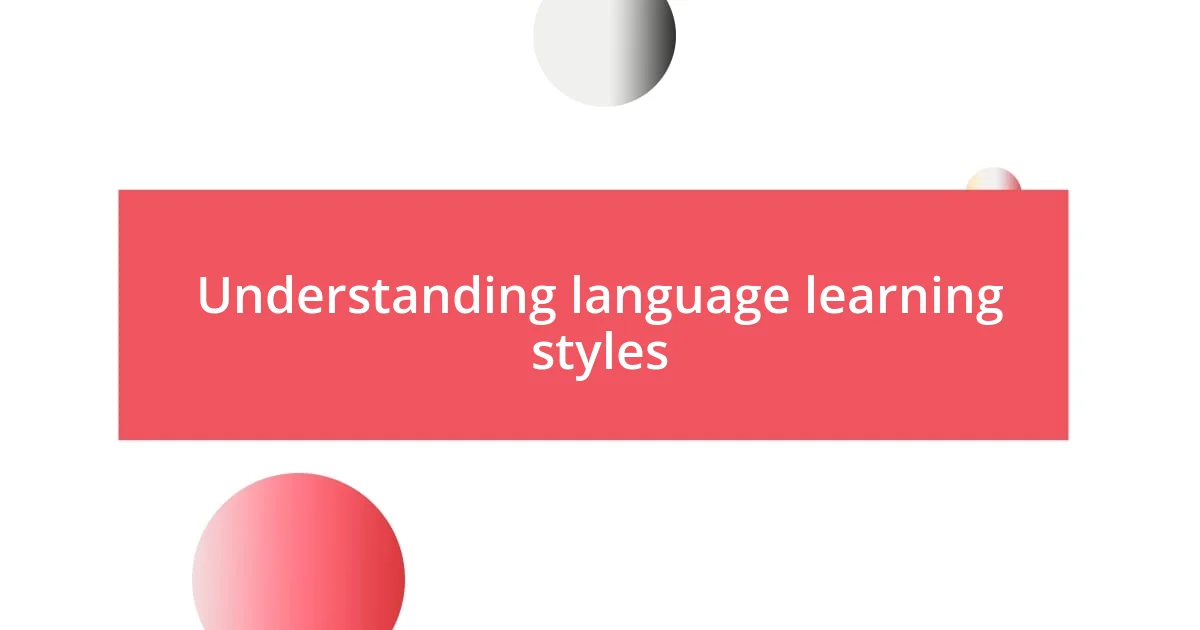Key takeaways:
- Understanding diverse language learning styles (auditory, visual, kinesthetic) can enhance a learner’s experience and effectiveness.
- Language acquisition theories (behaviorist, nativist, constructivist) provide insights into how different methods contribute to learning languages.
- Personalizing study plans and incorporating varied techniques, alongside regular reflection on progress, significantly boosts language learning motivation and retention.

Understanding language learning styles
When I first delved into the realm of language learning styles, I realized how profoundly different each person’s approach can be. Some learners thrive on auditory experiences, absorbing information through listening—like I did when I was captivated by podcasts in Spanish. I remember trudging through a basic vocabulary book, but it wasn’t until I started listening to native speakers that the words began to come alive for me.
Visual learners, in contrast, find themselves drawn to images, charts, and written text. I once met a friend who transformed her learning through mind maps. She would create colorful diagrams that connected new vocabulary to vivid illustrations, and witnessing her engagement sparked an idea: could visual aids be the missing link for many struggling students?
Then there are kinesthetic learners, those who learn best by doing. As someone who enjoys hands-on activities, I often found myself looking for opportunities to practice conversations in real-life situations. Reflecting on my own experiences, I can’t help but wonder how many students are missing out if their educators don’t cater to these diverse styles? It’s fascinating to think about how we can unlock a learner’s full potential by understanding and embracing these different approaches.

Theories of language acquisition
Language acquisition theories offer various perspectives on how individuals learn languages, and I’ve found this fascinating interplay to be immensely valuable. The behaviorist theory, for instance, emphasizes reinforcement in language learning. I think back to when I first learned verb conjugations in French; my teacher frequently used games to reinforce what we’d learned, making the process enjoyable and effective. This method highlights how praise and repetition can create a solid foundation for language acquisition.
Another prominent theory is the nativist perspective, which suggests that humans are biologically predisposed to learn languages. Reflecting on my experiences, I recall how effortlessly I picked up certain language patterns while chatting with my exchange student friend. It felt as if there was an innate ability kicking in, allowing me to grasp nuances of her native dialect without the gloss of memorization. This idea intrigues me, as it supports the notion that we might all have an intuitive capacity for language learning waiting to be unlocked.
In contrast, the constructivist theory posits that learning is an active, constructive process where individuals build new knowledge based on their experiences. One of my most memorable moments was during a group language exchange meetup. We shared stories, ideas, and laughter, collaboratively shaping our understanding of each other’s languages. This approach made me appreciate how personal interactions can shape and enhance language acquisition, reinforcing the idea that social context plays a significant role in the learning process.
| Theory | Description |
|---|---|
| Behaviorist | Focuses on reinforcement and response, suggesting that learning occurs through conditioning. |
| Nativist | Posits that humans have an innate ability to acquire language through pre-existing cognitive structures. |
| Constructivist | Emphasizes active learning through social interactions and personal experiences, enabling learners to build knowledge collaboratively. |

Identifying your learning style
One of the first steps in identifying your learning style is tuning into how you naturally absorb information. I remember struggling with grammar rules until I realized I was an auditory learner. Listening to songs in the target language brought melodies and phrases to life, allowing me to recall them effortlessly. Understanding this about myself led to richer learning experiences.
To help you determine your own learning style, consider these questions:
- Do you prefer to learn through listening, watching, or hands-on activities?
- When studying, do you often jot down notes or draw diagrams?
- Do you feel more engaged when you can physically interact with learning materials?
- What methods have you used in the past that felt the most effective?
By reflecting on these aspects, you can better understand how you learn and tailor your language journey to fit your unique style, making the process much more enjoyable.

Visual strategies for language learning
In my journey of language learning, I’ve found that visual strategies can significantly enhance retention and understanding. For example, I began using mind maps to organize vocabulary. It was like creating a visual web of words that sparked connections in my mind, allowing me to see how terms related to each other contextually. Have you ever tried mapping out your thoughts? It feels like unlocking a door to deeper comprehension.
Flashcards have also been a game-changer for me. Initially, I thought they were just simple tools for memorization, but I soon realized their potential in learning with images. Pairing words with relevant visuals enriched my learning experience and made the vocabulary stick in my mind more effectively. I recall sitting on my couch, flipping through a stack of colorful cards, and feeling a sense of accomplishment when I could recall the meanings effortlessly. Isn’t it delightful when a learning tool works so well that it feels almost magical?
Infographics and charts have also helped clarify complex grammar rules. I remember struggling with the different tenses in Spanish, but I found an infographic that laid it all out visually. It was incredible how a single image could simplify the information I had been wrestling with for weeks. Visualizing these tense relationships helped me grasp the concept much faster than I ever thought possible. Have you ever seen a chart that made a complicated topic click for you? It’s like having a light bulb moment!

Auditory techniques in language education
In my experience, auditory techniques have transformed how I engage with a new language. Listening to podcasts in the target language became a daily routine for me, and I could feel my comprehension skills sharpening. Have you ever noticed how certain voices or intonations can make words resonate more deeply? That connection truly enhances retention.
One effective strategy I’ve used is having conversations with native speakers over the phone or via language exchange platforms. The immediacy of a spoken dialogue pushed me to think on my feet and respond quickly. Do you remember the rush of excitement when you successfully navigated a real conversation? That thrill reinforces learning in a way that written exercises simply can’t match.
Incorporating music has also been a game-changer in my language learning process. I vividly remember singing along to my favorite songs, which not only improved my pronunciation but also embedded vocabulary in my memory. There’s something magical about having catchy tunes in your head, making it easier to recall phrases when you need them. Have you ever caught yourself singing a song and effortlessly recalling the lyrics? That’s the power of auditory learning in action!

Kinesthetic approaches to language practice
Embracing kinesthetic approaches to language practice has genuinely revitalized my learning experience. I remember one afternoon, my friend and I turned vocabulary drills into a lively game, where we would act out different words. Movements not only made learning more fun but also helped cement the meanings in my mind. Have you ever found yourself laughing while learning? It turns out that joy can be a powerful teacher!
One of my favorite kinesthetic techniques involved using everyday objects to reinforce language concepts. For instance, I labeled items around my house with sticky notes, describing their use in both the target language and my native tongue. Each time I encountered these objects, I engaged in a mini vocabulary quiz. It felt incredibly rewarding to connect language learning with my daily routines. Imagine how much more engaging your learning could be if you turned your environment into a classroom!
Moreover, group activities have provided an interactive platform for practicing conversation. In a language club, we organized spontaneous role-playing scenarios that required us to step into different characters. I felt my confidence soar as I immersed myself in these lively exchanges. Doesn’t it feel fantastic when learning becomes an adventure? Kinesthetic practice has made my language journey not just educational but truly memorable.

Tailoring your study plan
When it comes to tailoring my study plan, I’ve realized that personalizing my approach is essential for effective language learning. I once mapped out how many hours I wanted to dedicate each week and what areas I wanted to focus on, then adjusted based on my progress. Have you ever felt the satisfaction of ticking off goals that truly resonate with you? That sense of accomplishment fuels motivation like nothing else.
I also found that mixing different study techniques in my schedule keeps things fresh and engaging. For example, I would alternate between watching films in the target language and writing short essays about what I learned. The excitement of discussing these films with friends made the language stick in my mind. Isn’t it intriguing how a simple change in routine can breathe new life into your studies?
Finally, I’ve discovered that reflecting on my learning journey is vital. Incorporating a weekly review session helped me assess what strategies worked best and where I needed improvement. It was enlightening to realize that some methods didn’t resonate with me as much as I thought they would. How often do you pause to reflect on your progress? Understanding my journey has not only personalized my study plan but has also deepened my passion for learning languages.















